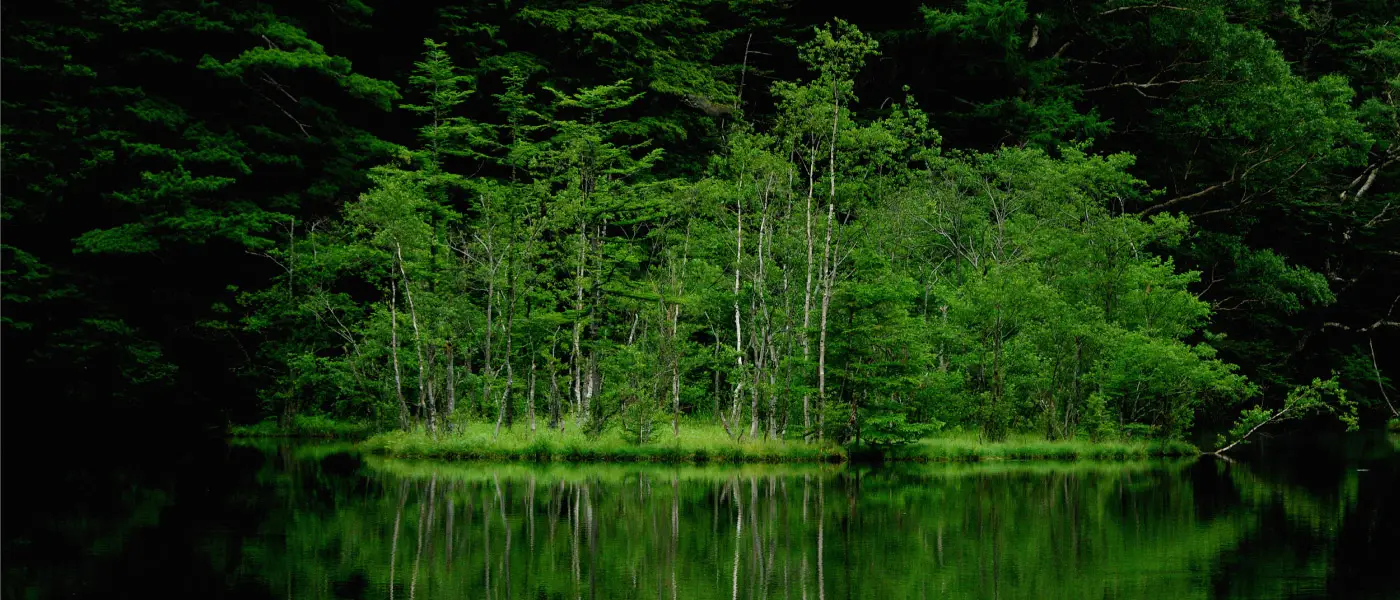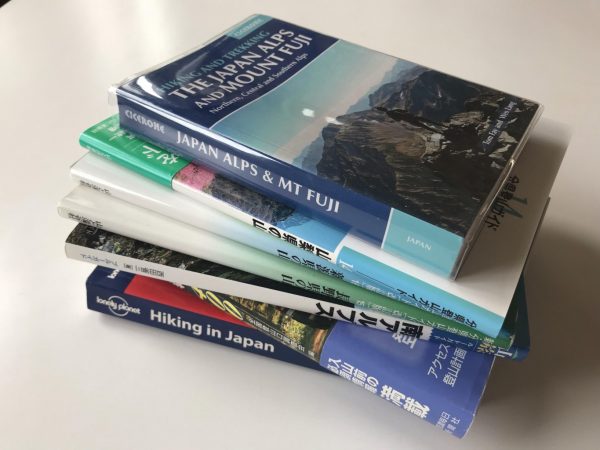
Some books on hiking and trekking in Japan from my own collection.
In recent years, many people have contacted our site with detailed questions about mountaineering in and around the Japan Alps. Answering such questions in a helpful manner is complicated by two things: concerns about giving inaccurate information that could put our readers in danger and the scarcity of English language resources to recommend for them.
If you read Japanese, you can easily consult resources, both in print and online, to satisfy your needs. Japan’s burgeoning range of hiking guides includes both prefecture-by-prefecture map books and whole volumes devoted to such niche topics as where to park your car near trailheads across the country. Online, you can find resources like the celebrated Yamareco, where contributors post detailed accounts of their journeys with helpful photo references. But if you don’t read Japanese, you might find this about as useful as a slab of Linear A. (Actually more useful thanks to the photos, but you take my point.)
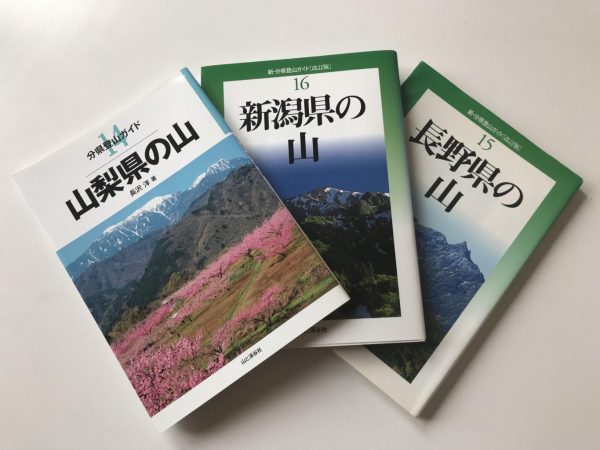
Japanese guides for hiking and mountaineering tend to be slender volumes focused on specific regions, such as one or more mountainous prefectures.
The field of English language resources got a valuable new addition earlier this year when mountain writers Tom Fay and Wes Lang released “Hiking and Trekking in the Japan Alps and Mount Fuji” (hereafter referred to as, "Hiking and Trekking"). This compact volume in a sturdy plastic jacket offers a comprehensive overview of the areas covered along with point by point directions on how to tackle selected hikes.
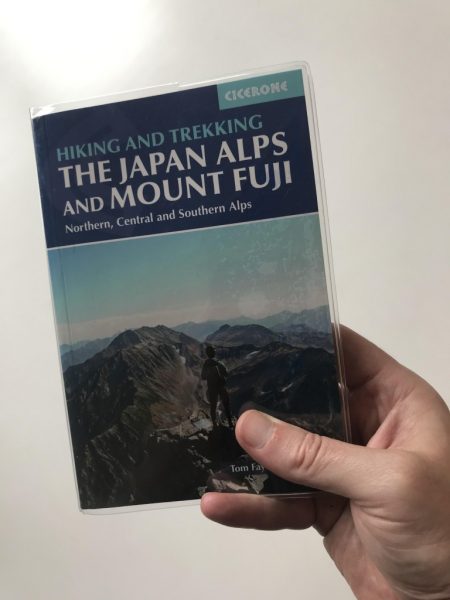
Hiking and Trekking in the Japan Alps and Mount Fuji is compact and girded for wear and tear.
We recently contacted Mr. Fay to get the skinny on the new book and the thinking behind it. Speaking to us from his home his Osaka, he tells of how he had been writing about the outdoors in Japan for a few years and started to formulate plans for a book back in 2015. As he explains, "The Lonely Planet 'Hiking in Japan' book had gone out of print and was becoming difficult to come by, and Paul Hunt's classic guidebook was even more out of date, so I felt there was a need for a good new English-language guidebook."
The Lonely Planet guide alluded to here can still be found online, albeit at inflated prices. Despite its many merits, the guide covers hikes all across Japan and as such tends spread itself thin. As mentioned above, hiking guides quickly go out of date as regards conditions on mountain trails. Consider the case of the popular Ontake-san whose trails only recently reopened after an eruption in 2014 resulted in a five year closure.
When asked about the merits of "Hiking and Trekking," Fay says, "this guidebook is much more up to date than the previous guidebooks for starters. Both Wes and myself know these mountains very well, but we re-walked every route in the book to make sure that every description and all the information is accurate. This guidebook also has way more color photos than the previous books."
The maps and color photos are certainly appreciated, as are the point by point explanations of the various twists and turns of the routes:
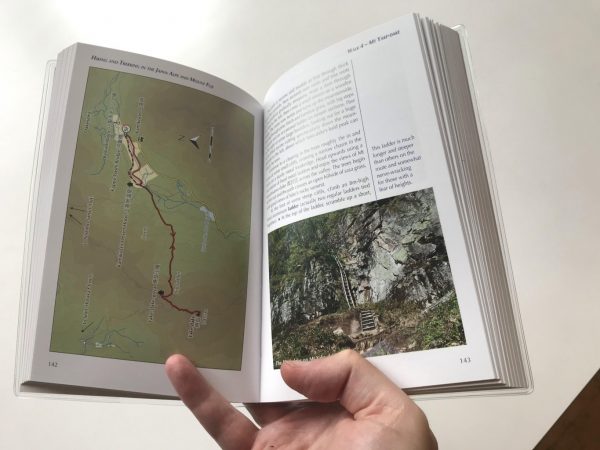
Detailed maps and full color photos supplement the written explanations of routes.
Speaking of advantages that "Hiking and Trekking" might have over online resources, Fay adds, "The main advantage is that the book is comprehensive and compact, making it easy to carry and refer to when hiking. All the information you need for your hike, including maps, access notes, hut info, useful Japanese words and characters etc are all there in one place. The guidebook runs to 400 pages but is quite small in size, so it is easy to stuff into a rucksack. It also has a plastic cover, meaning it is splash-proof and fairly robust, something which is always good for hikers."
It's not difficult to see how juggling a tablet while struggling to get a signal might pose a problem on craggy mountain trails above the treeline--just such a situation in which a reliably dog-eared book will see you through as has been the case for countless generations of travelers.
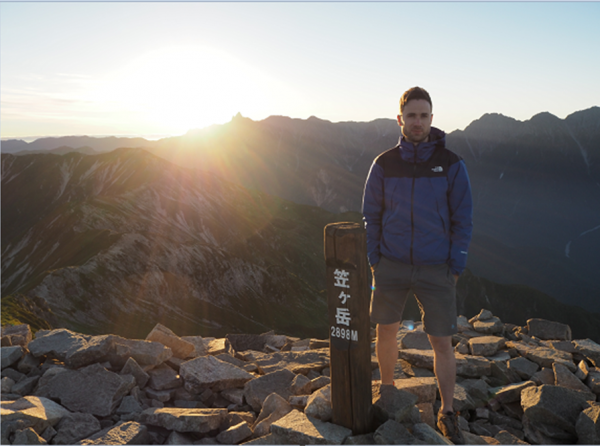
Author Tom Fay atop Kasagatake.
On the topic of his personal favorite hikes in the Japan Alps, Fay says, "I grew up close to Snowdonia in North Wales, and the mountains there are great for scrambling and climbing, so I've always tended to enjoy hikes that involve using your hands as well as your feet too. Mt. Tsurugi-dake in the North Alps is regarded as one of the most challenging mountains to climb in Japan as it requires a lot of climbing, and there are plenty of big, sheer drops, but it is great fun for competent scramblers, so it would have to be in my top three. Mt. Hotaka and its many thrilling ridges would also have to be included for the same reasons, with the two-day, up-and-over hike ascending via Dakesawa, followed by a descent into the spectacular Karasawa Cirque on day two making it a tough, but rewarding hike. Yake-dake is probably my favourite straightforward day hike in the Alps, as it has easy access from Kamikochi and is a walk with lots of variety - a nice forest start, followed by a steady climb and then an easy scramble up to the smouldering volcanic peak, with great views into the valley when the weather is clear. "
In closing, Fay tells us that he would someday like to revisit the Himalayas as well as explore some peaks in Central Asia...after crossing some still unconquered Japanese peaks of his list of course.
"Hiking and Trekking in the Japan Alps and Mount Fuji" is now available for purchase at a variety of online businesses as well as at Cicerone's homepage. And as an appetizer, check out Tom Fay's concise written intro to the Japan Alps. Be sure to check out co-author Wes Lang's popular Hiking in Japan site as well.
If you're in Japan and are confident enough in your command of the language to use a Japanese guide, you can choose from a wide variety on offer at any outdoor sporting shop as well as at big bookstore chains like Heiando.
Remember, careful preparation makes for safe and happy hiking and research based on up to date info sources is a key part of that.



